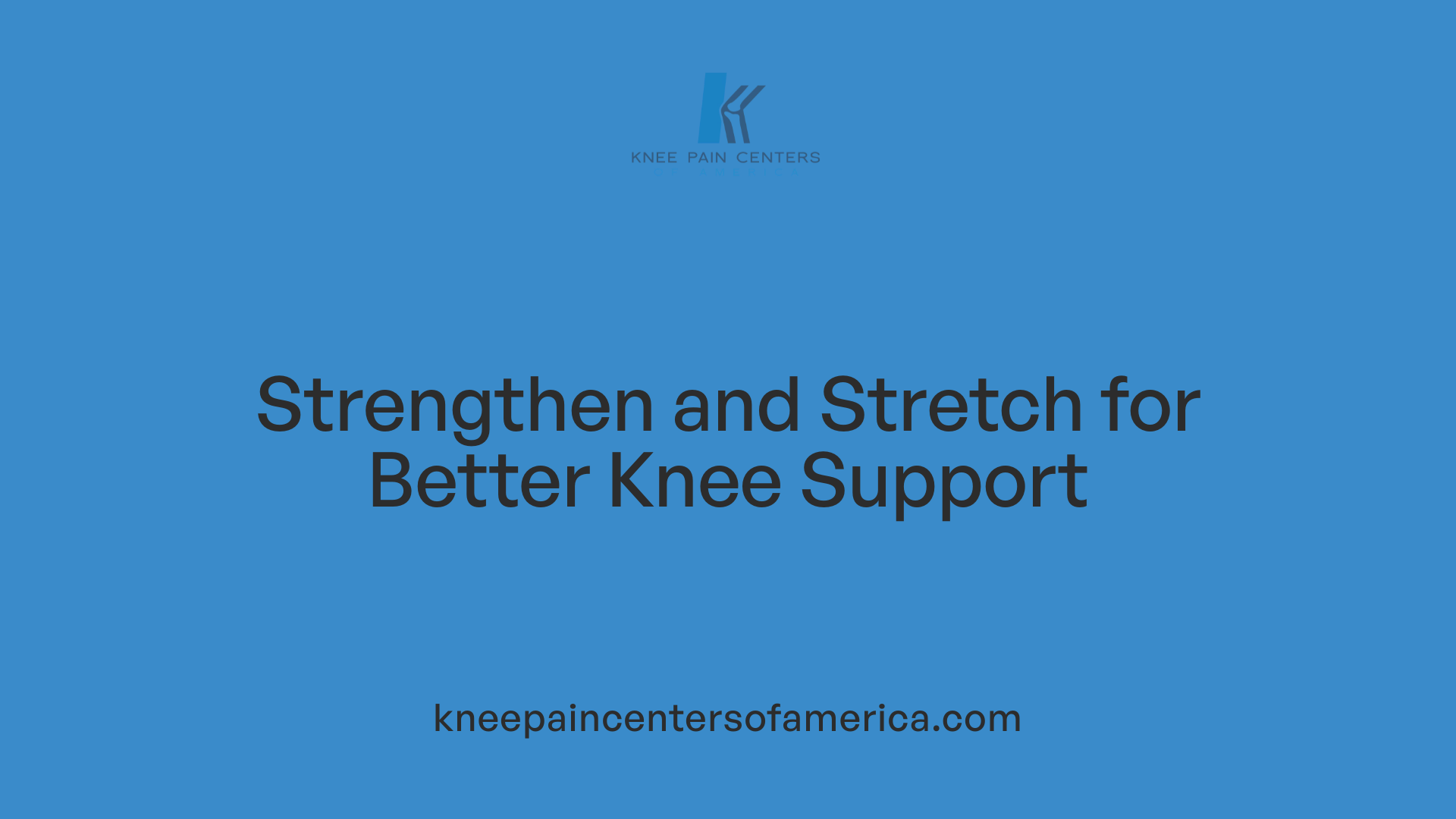Understanding and Addressing Knee Strain in Daily Life
Knee pain and strain are common issues that can significantly impact daily activities. From walking and sitting to exercising and household chores, many routine movements can strain the knee joint, especially when muscles are weak or tight. Fortunately, by modifying daily habits and incorporating targeted exercises, individuals can protect their knees, alleviate discomfort, and prevent long-term damage. This article explores practical ways to adjust activities, improve muscle support, and adopt lifestyle changes that promote knee health, all backed by scientific insights and expert recommendations.
The Role of Exercise in Knee Pain Prevention and Relief
Can exercise help reduce knee problems?
Yes, exercise plays a crucial role in easing knee pain and preventing further issues. Regularly strengthened muscles around the knee, including the quadriceps, hamstrings, and hip muscles, provide better support and stability to the joint. This support reduces strain on the knee, alleviates discomfort, and improves overall function.
Targeted exercises are especially helpful for managing conditions like patellofemoral pain, osteoarthritis, and degenerative meniscal tears. These exercises not only strengthen but also improve joint mobility, often delaying or avoiding the need for surgical intervention.
Stretching muscles that are tight around the knee, such as the hamstrings and quadriceps, enhances joint movement and reduces stiffness. Additionally, strengthening muscles in the hips and core helps distribute forces more evenly through the leg, offering further relief.
It is important to start with gentle activities, gradually increasing intensity to avoid aggravating symptoms. Consulting with healthcare professionals ensures exercises are performed safely and effectively. If pain worsens or persists beyond six weeks, medical advice should be sought to adapt the treatment plan.
The Impact of Lifestyle Choices on Knee Health

What lifestyle changes can help prevent knee pain and injury?
Making mindful lifestyle modifications plays a crucial role in preserving knee health. Maintaining a healthy weight is essential because excess weight increases the load on knee joints, leading to faster cartilage wear and higher risk of pain. By managing weight through diet and exercise, individuals can significantly reduce joint stress.
Engaging in low-impact activities such as swimming, cycling, and water aerobics helps to strengthen supporting muscles without placing excessive stress on the knees. These activities promote joint lubrication, improve mobility, and prevent stiffness, contributing to overall joint longevity.
Proper footwear is another vital component. Wearing supportive shoes with good cushioning and stable soles helps absorb shock during daily activities and exercises, providing additional stability to the knees. Avoiding high-heeled or unstable footwear reduces abnormal stresses that could accelerate joint degeneration.
A balanced diet rich in anti-inflammatory foods, such as fruits, vegetables, whole grains, nuts, and fish, supports joint health by reducing inflammation and providing essential nutrients for tissue repair. Incorporating foods high in omega-3 fatty acids, like salmon and flaxseeds, can further help manage joint inflammation.
In case of injuries or symptoms of knee pain, prompt management using RICE (Rest, Ice, Compression, Elevation) and seeking medical advice can prevent worsening conditions. Regular stretching and strengthening exercises for leg, hip, and core muscles enhance stability and reduce strain.
By implementing these healthful habits—maintaining an optimal weight, choosing gentle exercises, wearing proper shoes, eating anti-inflammatory foods, and addressing injuries early—individuals can protect their knees, mitigate pain, and maintain mobility for years to come.
Practical Daily Habits for Knee Pain Prevention
 Maintaining healthy daily habits plays a crucial role in preventing knee pain and maintaining joint function. Proper posture during standing and sitting is essential; avoid slouching or positions that place unnecessary strain on the knees. Sitting with knees at a 45-degree angle instead of a full 90 degrees reduces stress on the joint. When standing, ensure weight is evenly distributed to prevent overloading one knee.
Maintaining healthy daily habits plays a crucial role in preventing knee pain and maintaining joint function. Proper posture during standing and sitting is essential; avoid slouching or positions that place unnecessary strain on the knees. Sitting with knees at a 45-degree angle instead of a full 90 degrees reduces stress on the joint. When standing, ensure weight is evenly distributed to prevent overloading one knee.
Avoid prolonged periods of sitting or standing. Take regular breaks to move and stretch, which helps prevent stiffness and reduces muscle tightness around the knee. Use ergonomic chairs and workstations to support proper alignment.
Proper lifting techniques are vital for knee safety. When lifting heavy objects, bend at your hips and knees rather than your waist, and use your leg muscles to lift. Keep objects close to your body and avoid twisting your knees or body during the lift.
Breaking up repetitive motions, especially those involving knee bending or twisting, can prevent overuse injuries. Incorporate frequent movement changes and stretching routines into your daily activities.
Where necessary, utilize assistive devices like knee braces, orthotics, or supports to stabilize the joint during physical activity or prolonged standing. Make sure these devices are properly fitted and used appropriately.
Choosing proper footwear is also important. Supportive, cushioned shoes with appropriate arch support can absorb shock and reduce strain on the knees. Replace worn-out shoes promptly to maintain proper gait and joint alignment.
Implementing these habits, along with strengthening exercises and maintaining an active lifestyle, can significantly decrease the risk of knee discomfort and support overall joint health.
Activities and Movements That Minimize Knee Stress

What types of activities are recommended to minimize knee stress?
To effectively reduce strain on the knees, choosing low-impact, gentle exercises is essential. Activities such as swimming, cycling, water aerobics, Tai Chi, yoga, and walking provide the benefit of maintaining physical fitness without exerting excessive pressure on the knee joints. These options help avoid the harsh impact associated with high-impact sports like running or jumping.
In addition to aerobic activities, strengthening exercises focused on the muscles that support the knee—such as leg lifts, hamstring curls, and side-lying hip abductions—can enhance joint stability. Improved muscle support eases the load on the knee, lowering discomfort and reducing the risk of injury.
A gradual increase in exercise intensity and duration ensures that your knees adapt safely to new activity levels. Always start slow, especially after a period of inactivity or injury, and listen to your body's signals. Proper warm-up and cool-down routines are vital to prepare the joints and muscles before exercise and promote recovery afterward.
Maintaining a healthy weight through regular, low-impact physical activity can significantly lessen stress on the knees, especially in the presence of osteoarthritis. Supporting features like appropriate footwear, alignment corrections, and consulting healthcare providers can further enhance knee protection.
Ultimately, adopting these cautious movement habits and choosing activities wisely not only minimizes knee stress but also sustains mobility, alleviates pain, and promotes overall joint health.
Targeted Exercises for Knee Support and Flexibility

Are there exercises that can help alleviate knee pain and prevent strain?
Yes, targeted exercises play an important role in relieving knee discomfort and preventing future injury. These exercises focus on strengthening the muscles around the knee, such as the quadriceps, hamstrings, and hips, which provide support and stability to the joint.
One effective exercise is the straight-leg raise. This involves lying or sitting and lifting one leg while keeping it straight, helping to strengthen the quadriceps without putting much strain on the knee.
Stretching muscles like the hamstrings is equally vital. Hamstring stretches can improve flexibility and reduce stiffness around the knee. An example is the hamstring floor stretch, where you lie on your back and gently pull your leg toward you.
Strengthening exercises such as side-lying hip abduction target the outer hip muscles. Lying on your side and lifting the top leg helps stabilize the pelvis and supports the knee.
Using foam rollers for myofascial release can relax tight muscles around the thigh and knee area. Rolling out the hamstrings and quadriceps helps decrease muscle tension, improving joint movement.
Incorporating these routine activities—like yoga or tai chi—can further enhance joint mobility and balance, reducing the risk of strain.
Perform these exercises gradually, paying close attention to pain levels. Stopping or modifying an activity that causes discomfort is essential. Routine consistency, along with wearing supportive shoes and proper warm-up and cool-down sessions, maximizes benefits.
Always consult with a healthcare professional or physical therapist for personalized advice. They can recommend the safest and most effective exercises tailored to your specific knee condition, ensuring long-term health and mobility.
Medical Interventions and When to Seek Professional Help
Use of medication like NSAIDs and acetaminophen
When knee pain becomes significant or persistent, medications such as NSAIDs (non-steroidal anti-inflammatory drugs) and acetaminophen can provide relief. These help reduce inflammation and alleviate pain, allowing for better participation in physical therapy or daily activities. However, they should be used within recommended dosages and after consulting a healthcare provider.
Physical therapy and manual techniques
Physical therapy plays a vital role in managing knee pain that doesn't improve with home exercises. Therapists can teach targeted stretching and strengthening routines tailored to the individual's needs. Manual techniques, such as massage, joint mobilizations, and TENS (transcutaneous electrical nerve stimulation), can enhance symptom relief and improve joint function.
Assistive devices like braces and shoe inserts
Using supportive devices can stabilize the knee and decrease pain during activity. Knee braces, including prophylactic or unloader types, help offload pressure from damaged areas. Proper shoe inserts cushion impacts and promote proper alignment, which reduces stress on the knees.
Surgical options such as arthroscopy and knee replacement
In cases where conservative treatments fail, surgical procedures might be necessary. Arthroscopy allows for minimally invasive repair of meniscal tears or removal of damaged cartilage. For severe osteoarthritis, partial or total knee replacements can significantly restore mobility and reduce pain.
Injections including cortisone and PRP
Injections provide localized relief, especially when inflammation persists. Cortisone injections quickly reduce swelling and pain but are not suitable for frequent use. Platelet-rich plasma (PRP) injections support natural healing by promoting tissue repair and reducing symptoms, with fewer systemic side effects.
When to consult health professionals
Seek medical advice if knee pain persists beyond six weeks, worsens over time, or is associated with swelling, redness, or locking. Early consultation is crucial for proper diagnosis and treatment plan adjustments. Athletes or individuals with recent injuries should see a healthcare professional before returning to activity, especially if pain or instability occurs.
Maintaining awareness of symptoms and adhering to professional guidance ensures optimal recovery and aids in preventing further joint damage. For persistent issues, a multidisciplinary approach combining medication, therapy, and possibly surgery provides the best outcomes and helps restore mobility and quality of life.
Maintaining Long-Term Knee Health Through Conscious Habits
Effective knee care involves a combination of proper activity modification, targeted exercises, weight management, and seeking professional help when needed. By adopting low-impact activities, practicing good posture, supporting muscles through strengthening and stretching, and wearing suitable footwear, individuals can significantl reduce knee strain and pain. Regularly staying active with activities such as swimming or cycling keeps the joint mobile without overloading it. Additionally, addressing any early signs of discomfort promptly with appropriate rest, ice, compression, and elevation can prevent minor issues from becoming chronic problems. Consulting healthcare professionals for personalized guidance ensures safe practices and tailored interventions. Cultivating these habits not only alleviates existing discomfort but also fosters lasting joint health, enabling a more active and pain-free life.
References